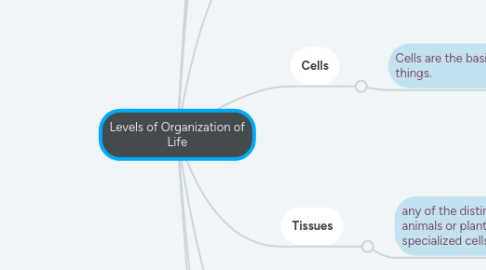
1. Atom
1.1. An atom is the smallest constituent unit of ordinary matter that has the properties of a chemical element.
1.1.1. the basic unit of a chemical element.
1.1.2. An atom makes up a molecule
2. Molecule
2.1. A group of atoms bonded together, representing the smallest fundamental unit of a chemical compound that can take part in a chemical reaction.
2.1.1. A molecule is an electrically neutral group of two or more atoms held together by chemical bonds.
2.1.2. Molecules are distinguished from ions by their lack of electrical charge.
3. Macromolecule
3.1. A molecule containing a very large number of atoms, such as a protein, nucleic acid, or synthetic polymer.
3.1.1. A macromolecule is a very large molecule, such as protein, commonly created by the polymerization of smaller subunits
3.1.2. They are typically composed of thousands of atoms or more.
4. Organelles
4.1. Any of a number of organized or specialized structures within a living cell.
4.1.1. Individual organelles are separately enclosed within their own lipid bilayers.
4.1.2. The name organelle comes from the idea that these structures are parts of cells
5. Cells
5.1. Cells are the basic building blocks of living things.
5.1.1. Cells provide structure for the body, take in nutrients from food and carry out important functions.
5.1.2. Cells are the basic structures of all living organisms.
6. Tissues
6.1. any of the distinct types of material of which animals or plants are made, consisting of specialized cells and their products.
6.1.1. A tissue is an ensemble of similar cells and their extracellular matrix from the same origin that together carry out a specific function.
6.1.2. Organs are then formed by the functional grouping together of multiple tissues.
7. Organs
7.1. Organs are collections of tissues with similar functions.
7.1.1. Organs are composed of main tissue, parenchyma, and "sporadic" tissues, stroma.
7.1.2. Plant and animal life relies on many organs that coexist in organ systems.
8. Organ System
8.1. The 11 organ systems of the body are the integumentary, muscular, skeletal, nervous, circulatory, lymphatic, respiratory, endocrine, urinary/excretory, reproductive and digestive.
8.1.1. An organ system is a group of organs that work together as a biological system to perform one or more functions.
8.1.2. Each organ system does a particular job in the body, and is made up of certain tissues
9. Organism
9.1. an individual animal, plant, or single-celled life form.
9.1.1. Organisms are classified by taxonomy into specified groups such as the multicellular animals, plants, and fungi; or unicellular microorganisms such as a protists, bacteria, and archaea.
9.1.2. Humans are multicellular animals composed of many trillions of cells which differentiate during development into specialized tissues and organs.

